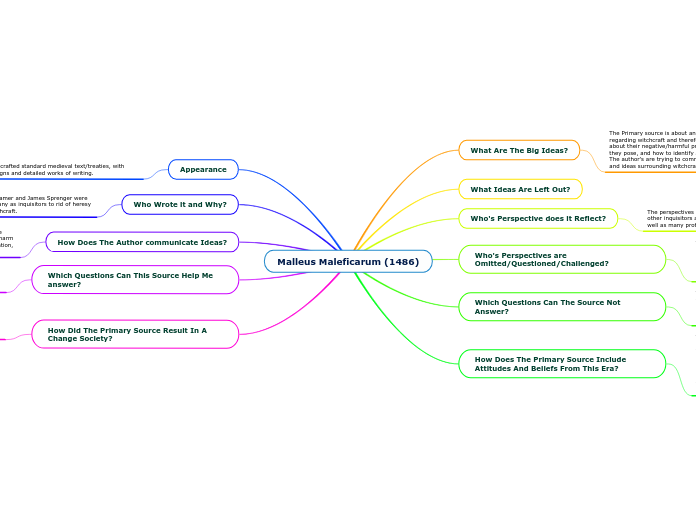Malleus Maleficarum (1486)
How Did The Primary Source Result In A Change Society?
Which Questions Can This Source Help Me answer?
This source can help me answer questions regarding how such a movement was able to begin, build credit, and become as big and long lasting as it did.
How Does The Author communicate Ideas?
The manual was divided into three parts; why witches are considered real or more than superstition, why/how real harm is caused by Maleficarum, and lastly methods of investigation, arrest, and punishment.
A paragraph structure is used by the authors in order to explain ideas and provide evidence as to why witchcraft exists.
Written in Latin, a formal tone is used to convey the author's beliefs regarding matters surrounding witchcraft, drawings depict methods of punishment such as burning, removing an eye, or a hand.
Who Wrote it and Why?
Dominican monks Heinrich Kramer and James Sprenger were enlisted by the pope of Germany as inquisitors to rid of heresy in the south surrounding Witchcraft.
The purpose of the book was to serve as a manual for those who believed-in, hunted, and/or prosecuted and executed Witches, as well as to serve as the official book on witches and witchcraft.
Appearance
A beautifully crafted standard medieval text/treaties, with intricate designs and detailed works of writing.
How Does The Primary Source Include Attitudes And Beliefs From This Era?
The Malleus Maleficarum included many popular beliefs from its era such as the existence of the Devil and daemons, which they believed witches to be compelling manifestations of (hence mainly women being targeted). Many Catholic and Protestant beliefs are entwined in the source as well and it's clear that women, community outsiders, and people of colour, who were already seen as lesser-valued beings were mainly the ones targeted and perceived to be greater threats than others in the community, capable of evil.
Which Questions Can The Source Not Answer?
The source can't answer why the opinions and beliefs held by those opposed to the idea/existence of witchcraft are false. Such as the innocent women accused and people's thoughts and opinions around witchcraft and its direct links to the old Pagan nature-based religion that's existed for centuries.
Who's Perspectives are Omitted/Questioned/Challenged?
The perspectives of those skeptical of witchcraft or who believe it to be superstition, as well as many female healers, peasants, community outsiders who were accused but innocent. Many educated noblemen also denied the existence of witchcraft but the trials were basically in the hands of society.
Who's Perspective does it Reflect?
The perspectives of the authors, the Pope of Germany, and other inquisitors are what's mainly reflected in the work, as well as many protestants and catholics beliefs around witches.
What Ideas Are Left Out?
What Are The Big Ideas?
The Primary source is about an ethnic/religious groups beliefs regarding witchcraft and therefor the devil/daemons. Talking about their negative/harmful presence in the world, dangers they pose, and how to identify and prosecute said witches. The author's are trying to communicate their personal beliefs and ideas surrounding witchcraft.

